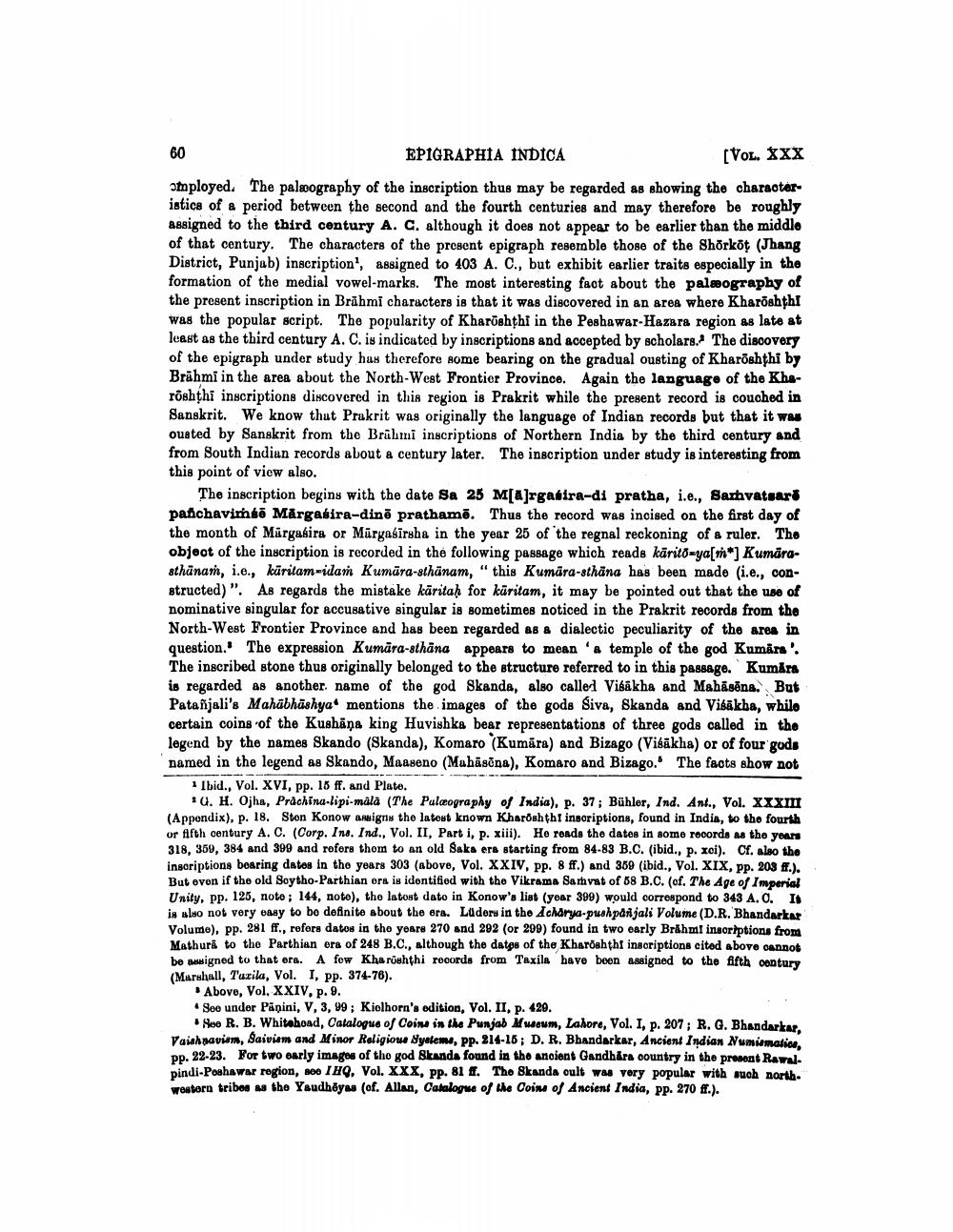________________
EPIGRAPHIA INDICA
[VOL. XXX stoployed. The palæography of the inscription thus may be regarded as showing the characteristics of a period between the second and the fourth centuries and may therefore be roughly assigned to the third century A. C. although it does not appear to be earlier than the middle of that century. The characters of the present epigraph resornble those of the Shorkot (Jhang District, Punjab) inscription, assigned to 403 A. C., but exhibit earlier traits especially in the formation of the medial vowel-marks. The most interesting fact about the palæography of the present inscription in Brāhmi characters is that it was discovered in an area where Kharoshthi was the popular script. The popularity of Kharoshthi in the Peshawar-Hazara region as late at least as the third century A. C. is indicuted by inscriptions and accepted by scholars. The discovery of the epigraph under study hus therefore some bearing on the gradual ousting of Kharðshthi by Brahmi in the area about the North-West Frontier Province. Again the language of the Kheroshthi inscriptions discovered in this region is Prakrit while the present record is couched in Sanskrit. We know thut Prukrit was originally the language of Indian records but that it was ousted by Sanskrit from the Brühmi inscriptions of Northern India by the third century and from South Indian records about a century later. The inscription under study is interesting from this point of view also.
The inscription begins with the date Sa 25 M[a]rgafira-di pratha, i.e., Samvatsar panchavimto Märgabira-dino prathamē. Thus the record was incised on the first day of the month of Märgasira or Murgabirsha in the year 25 of the regnal reckoning of a ruler. The object of the inscription is recorded in the following passage which reads kārito-ya[*] Kumārasthānam, i.e., kūritam-idam Kumāra-8thānam," this Kumāra-8thāna has been made (i.e., constructed)". As regards the mistake karitaḥ for kūritam, it may be pointed out that the use of nominative singular for accusative singular is sometimes noticed in the Prakrit records from the North-West Frontier Province and has been regarded as a dialectio peculiarity of the area in question. The expression Kumāra-sthāna appears to mean a temple of the god Kumar'. The inscribed stone thus originally belonged to the structure referred to in this passage. Kumars is regarded as another name of the god Skanda, also calle! Visakha and Mahäsēna. But Patañjali's Mahabhäshya montions the images of the gods Siva, Skanda and Vibākba, while certain coins of the Kushāna king Huvishka bear representations of three gods called in the legend by the names Skando (Skanda), Komaro (Kumāra) and Bizago (Višākha) or of four gods named in the legend as Skando, Maaseno (Mahäsēna), Komaro and Bizago. The facts show not
1 Ibid., Vol. XVI, pp. 15 ff. and Plate.
*U. H. Ojha, Prachina-lipi-mala (The Palæography of India), p. 37; Bühler, Ind. Ant., Vol. xxxm (Appendix), p. 18. Ston Konow ansigns the latest known Kharðshthi insoriptions, found in India, to the fourth or Afth century A. C. (Corp. Ins. Ind., Vol. II, Parti, p. xiii). He reads the dates in some records as the years 318, 359, 384 and 399 and rofors thom to an old Saks ers starting from 84-83 B.C. (ibid., p. xci). Cf. also the inscriptions boaring dates in tho years 303 (above, Vol. XXIV, PP. 8 ff.) and 369 (ibid., Vol. XIX, pp. 203 ff.). But even if the old Soytho-Parthian ora is identified with the Vikrama Samvat of 88 B.C. (of. The Age of Imperial Unity, pp. 125, noto; 144, noto), the latost dato in Konow's list (year 399) would correspond to 343 A. O. It is also not very easy to bo dofinito about the era. Luders in the Acharya.pushpalljali Volume (D.R. Bhandarkar Volume), pp. 281 ff., refors datos in the years 270 and 292 (or 209) found in two early Brahmi insoriptions from Mathurt to the Parthian ora of 248 B.C., although the dates of the Kharoshthi insoriptions cited above cannot be signed to that era. A fow Kharishthi records from Taxila havo boon assigned to the fifth century (Marshall, Tuzila, Vol. I, pp. 374-76).
Above, Vol. XXIV, p. 9. • See under Päņini, V, 3, 99; Kiolhorn's edition, Vol. II, p. 429.
Hoe R. B. Whitaboad, Catalogue of Coin in the Punjab Museum, Lahore, Vol. I, p. 207; R. G. Bhandarkar. Vaishnavism, Saivism and Minor Religiou. Syalems, pp. 214-16; D. R. Bhandarkar, Ancient Indian Numismatice, pp. 22-23. For two early images of the god skanda found in the ancient Gandhára country in the present Raval. pindi-Peshawar rogion, so I HQ, Vol. XXX, pp. 81 ff. The Skanda oult was very popular with such north. Gestora tribos n the Yaudhöyw (of. Allan, Catalogue of the Coin of Ancient India, pp. 270 ff.).




